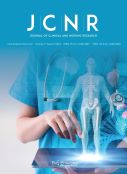Abstract
Objective: To observe the clinical effect of different frequencies of transcutaneous electrical acupoint stimulation in treating postpartum pelvic girdle pain and promoting postpartum rehabilitation. Methods: From January to September 2022, 300 patients with pelvic girdle pain after spontaneous delivery in a hospital in Shaanxi Province were selected and randomly divided into three groups, low frequency, high frequency, and alternating frequency, with 100 cases in each group. In addition to routine postpartum care and psychological counseling, the three groups received transcutaneous electrical acupoint stimulation at low-frequency (2 Hz,) high-frequency (100 Hz), and alternating frequency (2/100 Hz), respectively. The differences in initial pain, pain scores before and after treatment, satisfaction with analgesic effect, and postpartum rehabilitation effect were evaluated among the three groups of patients. Results: There was a significant correlation between maternal age and postpartum pelvic girdle pain (P < 0.001), but no correlation was observed between newborn birth weight and postpartum pelvic girdle pain (P > 0.05). After 1d/2d of treatment, the pain scores and rehabilitation effect of patients in the alternating-frequency group and low-frequency group were significantly better than those in the high-frequency group, and the postpartum curative effect of patients in the alternating-frequency group was the best, followed by the low-frequency group, and the high-frequency group; the differences were statistically significant (P < 0.001). Among the three groups, the alternating-frequency group had the highest satisfaction with the analgesic effect and the highest rate of selecting the same analgesic regimen the next time; the differences were statistically significant (P < 0.001). Conclusion: Transcutaneous electrical acupoint stimulation at different frequencies is safe and effective in treating postpartum pelvic girdle pain and beneficial to postpartum rehabilitation. Sparse-dense wave stimulation is effective in treating postpartum pelvic girdle pain. It has the best effect in promoting postpartum rehabilitation and the highest patient satisfaction. Therefore, its application in clinical practice is highly recommended.
References
Elden H, Gutke A, Kjellby-Wendt, et al., 2016, Predictors and Consequences of Long-Term Pregnancy-Related Pelvic Girdle Pain: A Longitudinal Follow-Up Study. BMC Musculoskeletal Disorders, 17(1): 276.
Wu J, Zhuo Y, Qin X, et al., 2020, Treatment of Postpartum Pelvic Pain with Pelvic and Sacral Tendon-Regulating Acupuncture Combined with Manipulation: A Randomized Controlled Study. Chinese Acupuncture and Moxibustion, 40(3): 262–266.
Xu F, Yang X, Hong Q, et al., 2021, Analysis of the Effect of Sanyinjiao Acupoint Massage on Relieving Postpartum Uterine Contractions. Naval Medical Journal, 42(6): 768–770.
Zhu W, Hu W, 2018, Pelvic Exercise Combined with Pelvic Floor Muscle Electrical Stimulation in the Treatment of Postpartum Pelvic Floor Dysfunction and Sexual Function Recovery. Chinese Journal of Family Planning, 26(12): 54–57.
Li X, 2014, Clinical Analgesic Progress of Transcutaneous Electrical Acupoint Stimulation. Chinese Journal of Pain Medicine, 20(11): 826–829.
Pan Y, 2012, Analysis of the Characteristics of Pelvic Girdle Pain and Its Impact on Daily Life in 216 Cases of Pregnant Women in Late Pregnancy. Journal of Nursing, 19(3): 51–53.
Liu Y, Zhong F, Shi W, et al., 2015, Application and Modern Theoretical Basis of Uterine Point in Gynecological Diseases. Shanghai Journal of Acupuncture and Moxibustion, 34(4): 364–366.
Dong G, Liu Y, Jin E, et al., 2014, Observation on Clinical Curative Effect of Local Acupuncture on Uterine Points for Primary Dysmenorrhea. Asia Pacific Traditional Medicine, 10(7): 76.
Lin C, Zhang L, Ma L, et al., 2016, Characteristics of Immediate Analgesic Effect of Sanyinjiao Point-Primary Dysmenorrhea. Chinese Science: Life Sciences, 46(8): 1015–1022.
Li J, Gao J, Chen S, et al., 2020, Analysis of Ancient Literature on the Treatment of Gynecological Diseases by the Uterine Point. Journal of Guangzhou University of Traditional Chinese Medicine, 37(4): 790–794.
